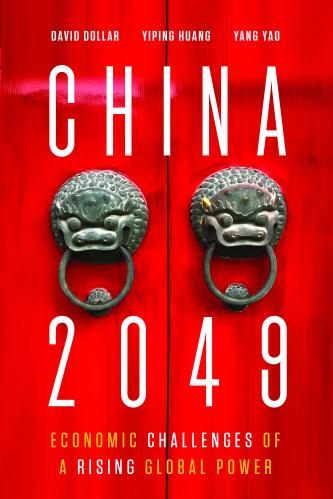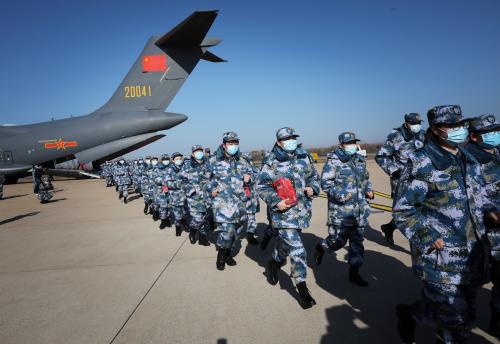The following is an excerpt from Reopening the World: How to Save Lives and Livelihoods, a new report where Brookings experts offer ideas to help policymakers protect lives and save livelihoods in the midst of the current COVID-19 pandemic.
 China was the first country hit by the coronavirus pandemic and the first country to go into recession in response to the health shock. Now, it is the first major economy reopening and getting back toward normal. It faces the challenge of reopening safely while the U.S., Europe, and others are in major recessions. The situation is still very uncertain and could go south very quickly so no one should be declaring victory at this stage, but are there any lessons so far that might be relevant to other countries, especially the U.S.? I see three lessons that are relevant for other places.
China was the first country hit by the coronavirus pandemic and the first country to go into recession in response to the health shock. Now, it is the first major economy reopening and getting back toward normal. It faces the challenge of reopening safely while the U.S., Europe, and others are in major recessions. The situation is still very uncertain and could go south very quickly so no one should be declaring victory at this stage, but are there any lessons so far that might be relevant to other countries, especially the U.S.? I see three lessons that are relevant for other places.
THE IMPORTANCE OF TESTING, TRACING, ISOLATING, AND QUARANTINING
As it got the virus under control, China continued to test, contact trace, isolate, and quarantine.
Getting the virus under control is the key to economic recovery. China delayed and covered up for several weeks at the beginning of the health crisis, which likely made the pandemic worse than it would otherwise have been and contributed to its spread to the rest of the world. But after that delay, China locked down a province of 50+ million people. Less well publicized is that local communities all over China took measures to limit coming and going and to take temperatures and test people who were traveling. As it got the virus under control, China continued to test, contact trace, isolate, and quarantine. Since then, there has been no major spread of the disease in the past month. China’s data, like the information from every country, probably understates the true number of cases and deaths. But if there were a major new hot spot, social media would be all over the story, even if posts were later taken down. We would know if there were major new outbreaks.
Some of the details of China’s response are worth emphasizing. In Wuhan, after the chaos of the first few weeks, people who suspected they had the virus were not directed to hospitals but rather to temporary drive-through testing sites so that they did not go unprotected into the hospitals. They waited for their results and if they tested positive, they were isolated in special makeshift hospitals for minor symptoms or ICUs for serious cases. Up until April 30, anyone returning to Beijing from elsewhere had to go into two-week quarantine in a hotel—they could not shelter at home and infect family members. Where cases have emerged, there is contact tracing with testing and, if necessary, isolation of the contacts. As China opens up, there is mandatory wearing of face masks at work and on public transportation.
There has been a lot of commentary about whether the measures implemented in China could be used in a democratic society like the U.S. South Korea has used the same basic playbook, with extensive testing, contact tracing primarily through the use of cell phones and electronic media, isolation, and quarantine. South Korea’s measures were less restrictive but more hi-tech than China’s, and it was able to control the virus quickly. As of mid–May, there have been more than 50 times more deaths in the U.S. than in South Korea, relative to population. That is 96,000 extra deaths in the U.S. because we have bungled the basic recipe of testing, contact tracing, isolation, and quarantine. Without that foundation, reopening the American economy could potentially be a disaster.
DEALING WITH AN UNEVEN ECONOMY
A second lesson from China is that it is hard to restart the economy, more so in some sectors than in others. As to be expected, the decline of the Chinese economy was breathtaking in February, as people all over the country were told to stay home. GDP declined 6.8 percent in the first quarter, compared to the year-before. Major activity indicators were all negative; for example, exports were down 17.2 percent in January-February; retail sales were off 20.5 percent; industrial production down 13.5 percent; and fixed asset investment down 24.5 percent. The Chinese economy was already starting to reopen in March, but the data that month were still quite negative, only less so than in January-February. For example, exports were down 6.6 percent, retail sales were off 15.8 percent, and industrial output fell just 1.1 percent. The fact that exports and industrial output were less negative than retail sales indicates that it is easier to restart factories than to get consumers to return to their old behaviors concerning travel, restaurants, movies, and shopping. Even with the virus apparently under control, and ubiquitous mask wearing, people are still nervous about going to places where large numbers of people congregate. Also, the whole experience is a reminder of the uncertainties and risks in life with the result that young people in particular are vowing to save more and spend less.
A variety of micro-indicators confirm this gradual and uneven recovery of the economy. The transportation congestion index for 100 cities showed that the halt in transportation during Chinese New Year, which is normal, continued for four weeks after the holiday. In mid-February the index was down 21 percent from the year before; but by mid-March the gap had narrowed to 11 percent. Coal use by five big power groups in coastal provinces was down to one-third of the pre-coronavirus level in mid-February; now it is back up to two-thirds the pre-crisis level. Small- to mid-sized enterprises (SMEs) are not faring as well, however. A big data study of SME revenue by the PBC School of Finance at Tsinghua University found that even at the end of March, revenue was down by about 60 percent compared to the year before. All of this is consistent with big manufacturing firms getting back close to normal, whereas SMEs in service sectors are struggling.
While the export and industrial production numbers were relative bright spots in the March data, the economy is likely to face what the Chinese are calling the “second shock” as export orders dry up in the face of deepening recessions in the U.S. and Europe. The April data are showing a drop in new export orders worse than during the global financial crisis. Containers full of Chinese goods are piling up at ports around the world. So, now, both large-scale manufacturing and small–scale service provision face problems of demand. Local governments are handing out consumption coupons to entice consumers to get back to restaurants, movies, and malls, but it is hard to get people to return to old behaviors.
HANDLING SPENDING CHANGES AND HOLES IN THE SOCIAL SAFETY NET
Third, and more speculatively, it is important to distinguish between the immediate drop in demand resulting from the shock to the economy, spending changes, and holes in the social safety net. The former requires a Keynesian stimulus in response. China’s fiscal stimulus so far has been less than that of the U.S. or Japan, but still amounts to a 5 percent of GDP fiscal impulse according to the International Monetary Fund. But as the economy returns toward normal, it is likely that people’s consumption habits have changed permanently or at least for the foreseeable future. There will be less travel, leisure, restaurant meals, even mall shopping—overall there will be less private consumption than on the prior growth path.
On the other hand, people want more of various government protections and services. In China, there are obvious weaknesses in the safety net and addressing them could be a new source of demand. In shaping the immediate stimulus, it is smart to think ahead to what new patterns of demand will look like. In China, there is a division between the education, health, and pension systems for the registered urban population (about 40 percent of the country) and the rural registered, about one-third of whom live in cities but without a full slate of urban benefits. The coronavirus crisis has revealed weaknesses in public health systems, care for the elderly, and education—all of which could be addressed through government programs. In switching to online classes, for example, rural areas have been disadvantaged by inferior internet connections. And there are probably many more cases of the virus in rural areas than we know about because there is not sufficient capacity for testing and treatment.
CONCLUSION
Every country, including the U.S., has its own weaknesses and challenges. The crisis has revealed the lack of preparation in the U.S. public health system and holes in the safety net. Even aspects of our infrastructure have come up short, such as internet connectivity in rural and poor areas. As the immediate economic crisis is overcome, and as seen in places like China, it makes sense to address these deficiencies both for social and economic reasons. Given low interest rates and the economic crisis, it makes sense for the American federal government to borrow whatever it takes to overcome the crisis. But somewhere down the road we will have to raise taxes if we are to have more public services on a sustainable basis, which is likely what people want. We may well look back in future decades and see the pandemic as the moment we realized that the era of small government is over. Going forward there is likely to be less demand for private consumption and more demand for public services.
The Brookings Institution is committed to quality, independence, and impact.
We are supported by a diverse array of funders. In line with our values and policies, each Brookings publication represents the sole views of its author(s).









Commentary
Reopening the World: China recovers first – with what lessons?
June 16, 2020